Shrub roses: what are they and how to grow them?
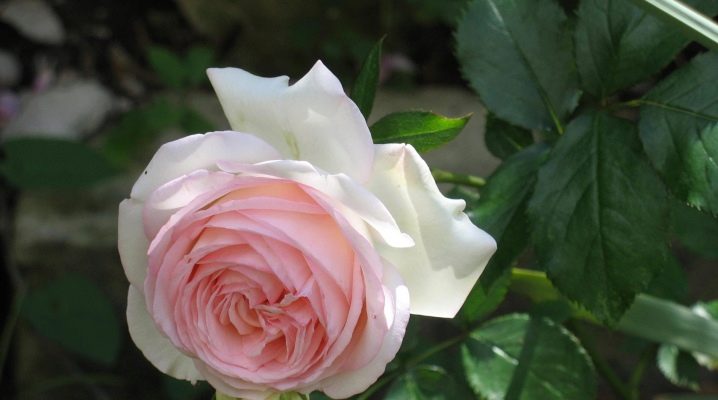
Shrub roses appeared more than 50 years ago. They immediately began to rapidly gain popularity among gardeners. Plants have acted as an excellent alternative to whimsical and thermophilic varieties, thanks to which they have become one of the most cultivated species in our country.
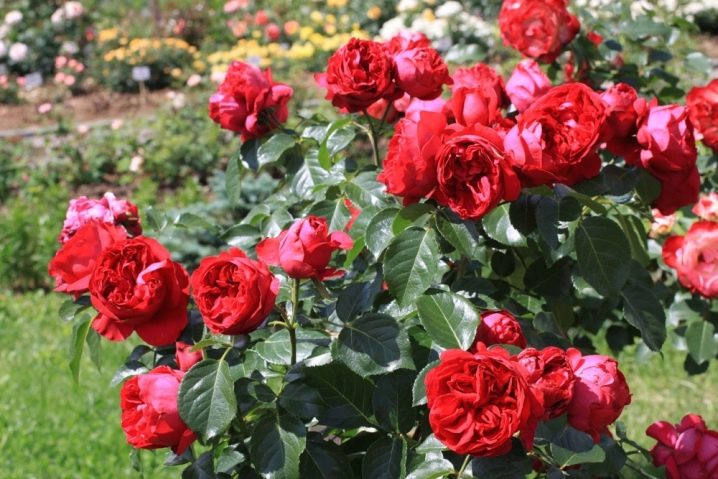
What it is?
Rose shrub (from English shrub) is a flowering shrub that can easily endure cold winters. At the same time, some varieties, for example, the Canadian rose-scrub, easily withstand 40-degree frosts. Plants of this species belong to the category of parks and are widely used by landscape designers and gardeners. Today, the number of varieties of rose-scrubs is several dozen. Experts conditionally subdivide them into three categories, each of which contains plants with similar morphological characteristics. The classification is informal and is used only to structure data when describing varieties.
- The first group includes English shrub roses, bred by the famous British breeder David Austin at the end of the last century. Their distinctive feature is the unusual "English" shape of the flower, for which the plants received the unofficial name "nostalgic roses". Individuals of Bourbon, Damascus and French roses, as well as specimens of modern varieties of hybrid tea roses and Floribunda were taken as parental pairs. English shrub roses are distinguished by their unsurpassed aroma, long flowering times and powerful buds. The group includes a large number of hybrids with different growth rates and shoot heights.
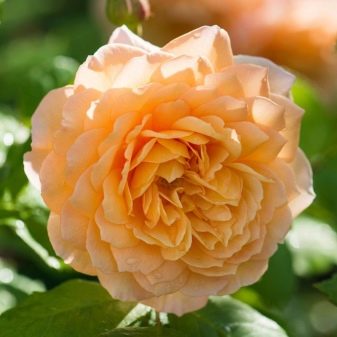

- The second group includes ground cover roses, the height of which can vary from 20 cm to 2 m. Shrubs belonging to this group can be creeping or drooping. They are distinguished by high decorative properties and unpretentiousness. During flowering, the plant covers the ground with a lush carpet, giving the garden space an elegant look.
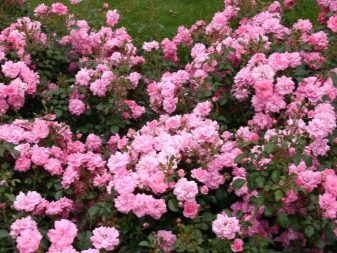

- The third group of rose scrubs is represented by plants Canadian selectioncapable of withstanding temperatures down to -40 degrees. This category is the most frost-resistant and most common in areas with a temperate and sharply continental climate.

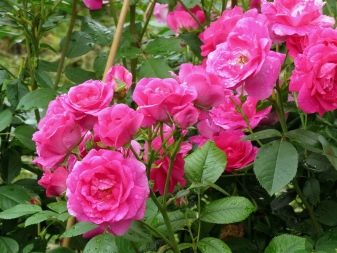
In addition to the obvious differences, there are also a number of features that are characteristic of all plants of a given species.
- Shrub roses are characterized by continuous flowering, which begins in early June and ends with the onset of the first frost. Flowers replace each other throughout the growing season, thereby increasing the decorative properties of the shrub. The only exception is the variety "Fritz Nobis" (lat. Fritz Nobis), which is a single flowering plant.
- The species is distinguished by a wide variety of inflorescences, among which there are both classical shapes and textures, and buds that are completely unusual in their color and structure.
- Almost all varieties of rose scrubs have a bright and rich aroma, thanks to which the shrub literally smells fragrant throughout the entire flowering period.
- Frost resistance is one of the most important qualities of a shrub, which favorably distinguishes it against the background of other types of garden and park plants.
- Shrub roses are immune to most diseases typical of other types of roses, which, combined with their absolute unpretentiousness, makes them the best option for novice gardeners.
- Bushes of almost all varieties are distinguished by their density, power and volume, and some specimens reach 2 meters in height and often act as the main decoration of the garden.
- Shrub roses go well with any other types of roses, they can be grown with them in the neighborhood without fear.
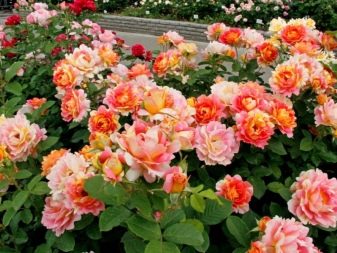

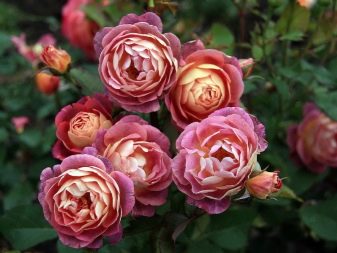

Despite the fact that shrub roses have many advantages over other decorative species, the shrub still has disadvantages. These include the need to shelter plants for the winter and regular pruning.
Varieties
Due to the absolute simplicity of care and resistance to diseases, shrub roses are the object of close attention of breeders, who are breeding more and more new hybrids. In this regard, it is more correct to start a review of popular varieties with new species obtained by the famous breeder David Austin. All plants bred by him are representatives of the so-called English group, differ in the brightness of colors and the uniqueness of the aroma of flowers.
- Variety "Desdemona" (Eng. Desdemona) is characterized by light peach-colored ovaries, which, when the bud opens, acquire a white color with a slight pinkish tinge. The flowers exude the scent of myrrh, perfectly retain their shape after strong winds and heavy rains.
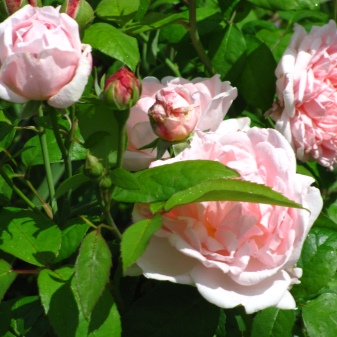

- Rose-scrub "Ansent Mariner" (English The Ancient Mariner) is distinguished by its bright pink double flowers of large size, evenly covering the entire bush. A characteristic feature of the variety is the golden-colored stamens and the plant's ability to bloom continuously until the onset of cold weather.
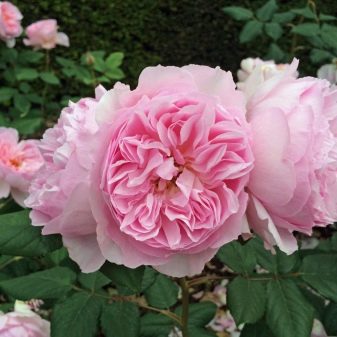
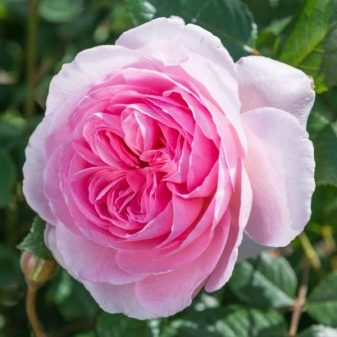
- Variety "Poets Waif" (English The Poets Wife) is distinguished by a low spherical bush and bright lemon-colored flowers that are not prone to fading. At the initial stage of flowering, the bud exudes a persistent lemon scent, and at the last stage, it acquires a sweetish note.
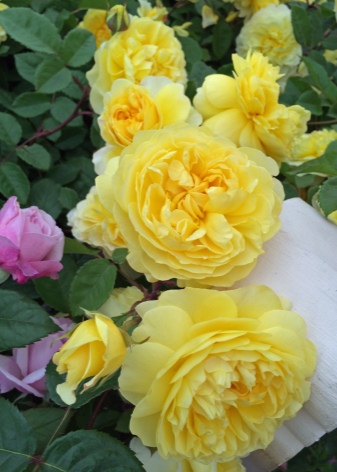

- Rose-scrub "Tranquillity" (English Tranquility) is a round bush with snow-white flowers and apple scent. Due to its high decorative qualities, the variety is often used for landscaping parks and squares.
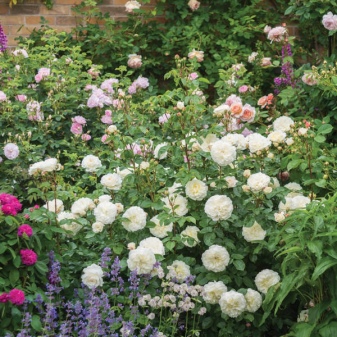
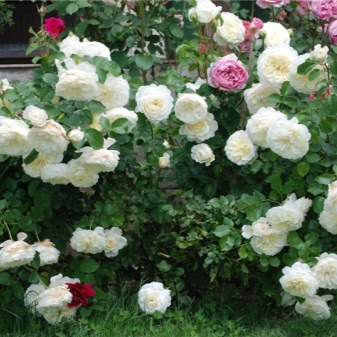
Earlier varieties are equally popular. Below are a number of plants, the mention of which is especially common.
- Variety "Bonanza" (Bonanza) is a long-flowering shrub with petals of different colors: the inner part of the bud is sunny orange, and the outer part is pink. When the bud is fully opened, you can see the golden-colored stamens inside. A characteristic feature of the variety is its self-cleaning ability, which is why the plant does not need pruning and independently regulates its leaf cover and the number of buds.
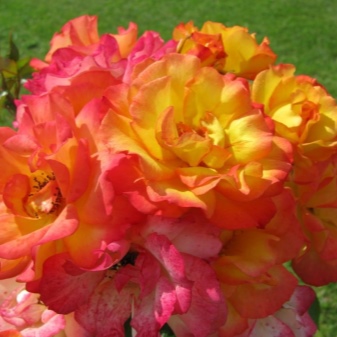
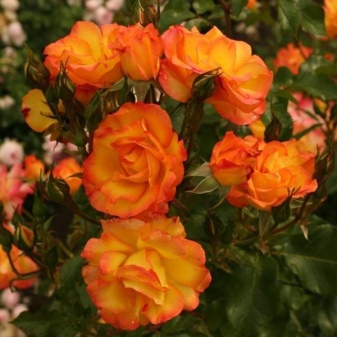
- Rose-scrub "Belvedere" (Belvedere) has large peach-colored flowers and looks great in group plantings. The plant has a slightly tart aroma that lasts throughout the flowering period. When the most favorable conditions are created, some bushes grow up to 1.2 m. Flowering occurs continuously, but the most intense flower formation occurs in the first wave, followed by several more weaker cycles. The disadvantage of the variety is its increased, in comparison with other species, susceptibility to various diseases, for example, powdery mildew.
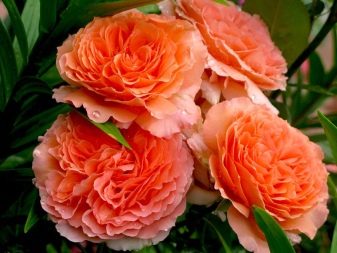
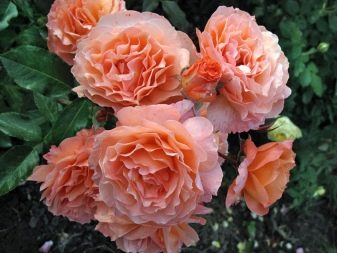
- Rose-scrub "Annie Duprey" (lat. Anny Duperey) is a shrub up to 100 cm high with bright lemon-yellow flowers with a light citrus scent. The plant is able to withstand frosts down to -23 degrees, is highly resistant to diseases such as powdery mildew and black spot. The disadvantage of the variety is its poor resistance to rain, in which the buds do not open.
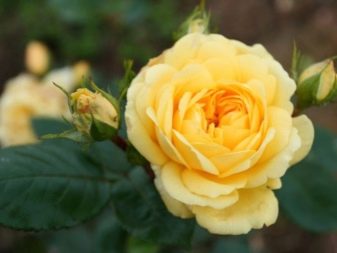
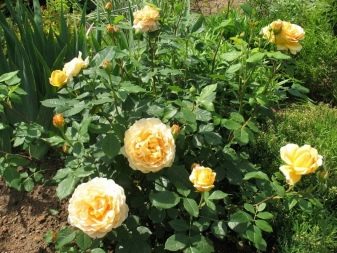
- Variety "Schneevitchen" (lat.Schneewitchen) was bred in 1958, is one of the earliest. The bush grows up to 150 cm, is distinguished by powerful branching. The plant has small light green buds that turn into semi-double white flowers 6-7 cm in size. The flowering is abundant and continuous throughout the growing season. There is also a high resistance to diseases and pests, which makes the variety very popular among novice summer residents and gardeners.
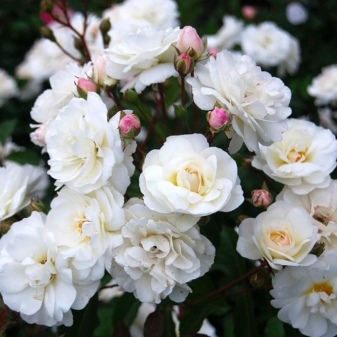
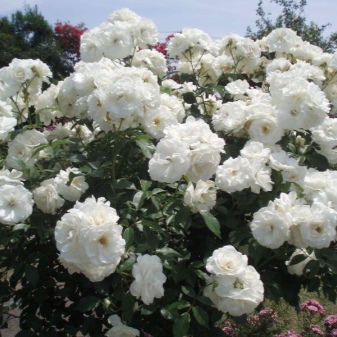
- Rose-scrub "Abraham Derby" (lat. Abraham Darby) is a strong round-shaped shrub up to one and a half meters high. The plant is distinguished by classic-shaped buds, which turn into densely doubled pale pink or apricot flowers. The variety is early flowering and blooms continuously until the very cold. The plant has shiny leaves, is disease resistant and easy to care for. The only drawback is the tendency of flowers to droop, which is due to their large size (up to 14 cm) and heavy weight. The rose can withstand temperatures up to - 29 degrees, but it has a weak resistance to rain, during which the flowers do not open.
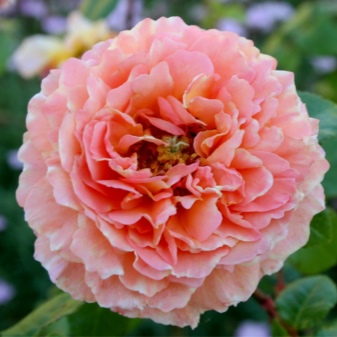
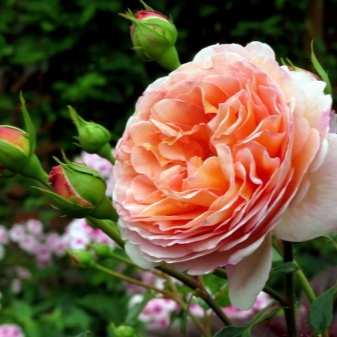
- Variety "Rococo" represented by a shrub up to 150 cm high, covered with large (up to 10 cm) apricot flowers. The flowers are arranged in clusters, have unusual wavy double petals, they perfectly withstand the effects of rain and strong side winds. During flowering, the petals fade a little, and at the final stage they become pearl-cream. The plant is highly resistant to powdery mildew and black spot.


- Rose-scrub "Manstead Wood" (Rose Munstead Wood) is a variety bred by D. Austin, which is a bush up to 100 cm high. The dark red velvet flowers have up to 75 petals and are distinguished by a blackberry aroma with subtle blueberry and plum notes. The frost resistance of the variety is -23 degrees, there is no particular predisposition to diseases.
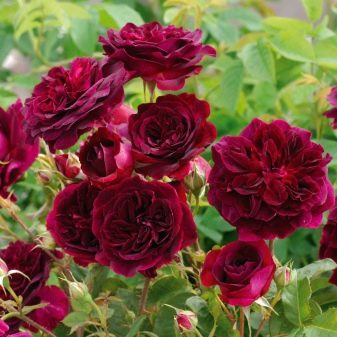
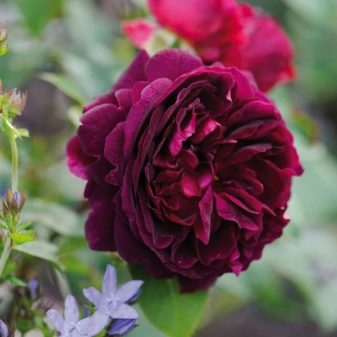
- Variety "Blanc Meyandecor" belongs to the ground cover group and is undersized. Its height varies from 30 to 50 cm, but the diameter of the flower reaches 10-15 cm. The buds have 70-80 pure white petals, and flowering lasts from early June to late October. The difference between "Blanc Meyandecor" from other varieties is the ability to withstand temperatures below -40 degrees, as well as high resistance to fungal diseases.

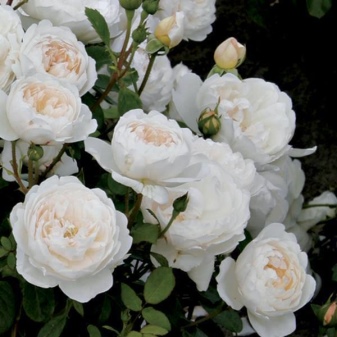
- Rose-scrub "Artemis" (lat. Artemis) is able to withstand frosts down to -23 degrees, is a rather demanding plant to care for. The variety needs a drainage system, regular feeding and good lighting. The bush looks good both against the background of landscape compositions and with a single planting.
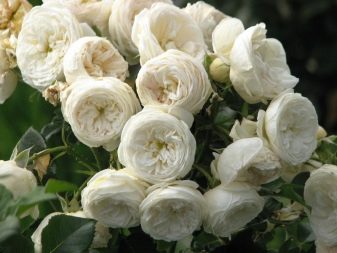
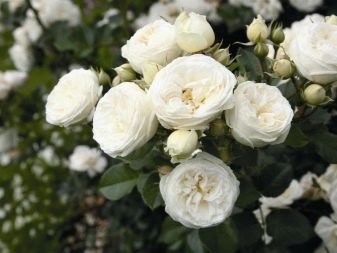
- Variety "Cosmos" very resistant to black spot, differs in cup-shaped densely double flowers of a creamy white hue, with a light aroma.
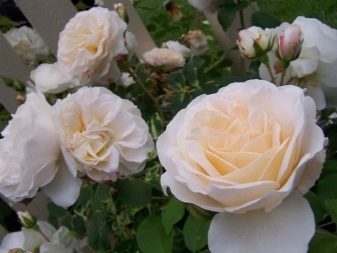

Landing
The key to good plant health is the correct selection of seedlings and the correct planting. The best option is annual roses, carefully dug up and well preserved. When buying them, the first thing to do is to carefully examine the bark, which should have all the signs of lignification., however, do not be wrinkled and too dry. You should also pay attention to the roots. Slight dryness is not a serious drawback and can be easily corrected by placing them in cold water for a day. The next step will be the selection and preparation of a planting site, which will entirely depend on the variety of roses. So, plants with strong bushes and flowers that do not burn out in the sun can be placed in a well-lit area, while varieties prone to loss of color of the buds are best placed in a slightly shaded place.

The size to which an adult plant grows should also be taken into account.So, when planting a voluminous and tall shrub, it is necessary to choose a site where neighboring bushes can be placed at a distance of one and a half to two meters from each other. However, when planting large varieties, it should be remembered that over time, their trunks will become lumber and will not have a leaf cover. Therefore, undersized varieties are usually planted in front of tall plants, which can subsequently close the bare trunks. Smaller roses can be planted 50 cm apart. The landing pattern is as follows:
- a couple of weeks before the event, peat or compost is introduced into the soil and dug well;
- the holes are usually made square in size with a size of 0.5x0.5 m and a depth of 50-60 cm;
- the prepared hole is filled by 1/3 with soil and abundantly watered with a solution of fertilizers;
- the seedling is placed in the middle of the hole, the roots are straightened, carefully sprinkled with earth and lightly tamped;
- the soil around the stem is mulched with sawdust and watered with clean water.
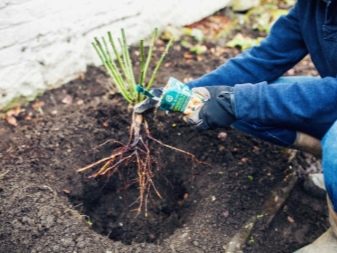


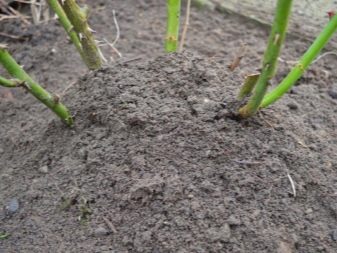
The best time for planting rose scrub is considered the second half of spring, when the ground warms up above 10 degrees, as well as early autumn.
Care
Growing rose shrub is not difficult even for beginners. Plants do not require special conditions, and care consists in regular watering, pruning and preparation for wintering.
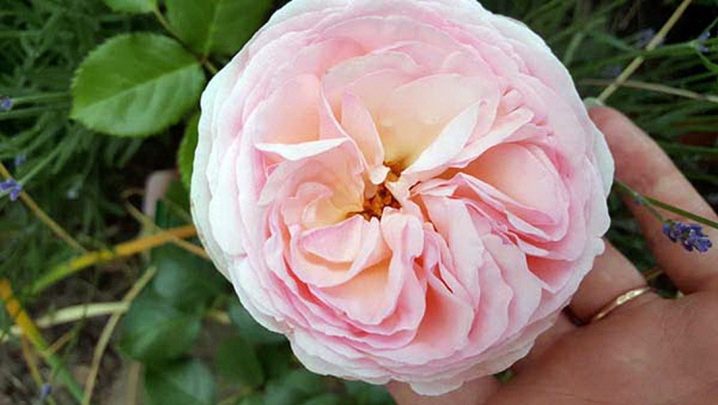
Watering
Shrub roses need infrequent abundant watering and seasonal feeding, consisting of preparations based on potassium, calcium and phosphorus. Watering the plants often and little by little is not recommended, as this can lead to their gradual wilting. When growing bushes in dry and hot climates, roses should be watered once a week, and in regions with moderately humid and humid climates - once every 10 days. Watering is recommended early in the morning or late in the evening after sunset.
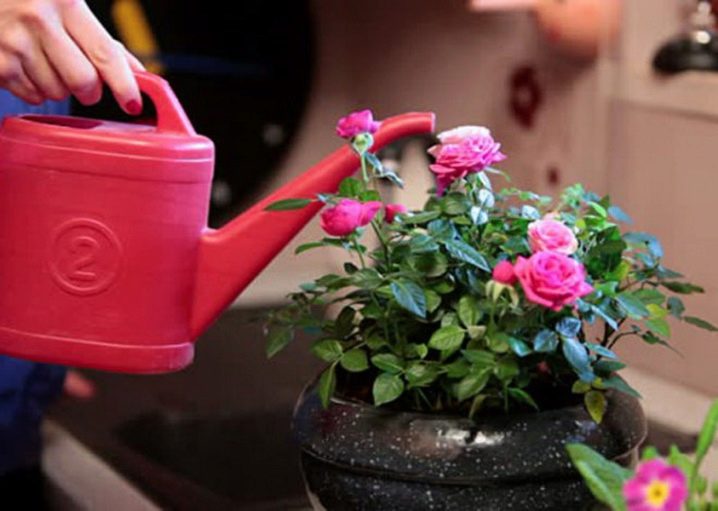
Pruning
Almost all varieties of rose scrubs need regular pruning to rejuvenate the bushes. Autumn pruning is considered the most significant, which is recommended to be performed in the process of preparing plants for winter. At this time, young and immature branches are removed, which is due to their ability to accumulate a large amount of moisture, which will turn into ice in winter. In addition to the young growth, the remaining leaves and buds, as well as diseased and suspicious branches, are subject to removal. If they are not removed, then the remaining organic matter will begin to rot and provoke the appearance of fungal infections.
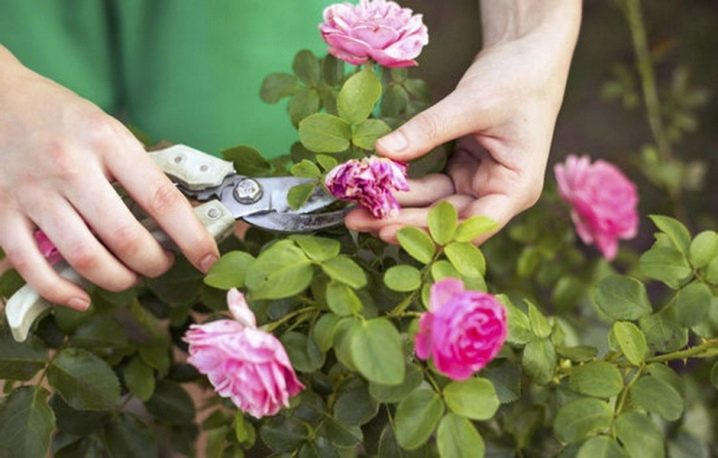
The next pruning is done in the spring, just after the plants open. At this stage, the frozen and dead branches are cut off, leaving only the strongest, with a large number of buds. The main stems are to be shortened by about 1/4, and the side shoots by 1/3. Only the top of the head is cut off from the arched branches, and the undersized erect shrub is cut in half. When pruning, it is necessary to ensure that at least 8 buds remain on each truncated shoot. Every three years old shoots are cut out, thus rejuvenating the bush.

Shelter for the winter
Despite the high frost-resistant qualities of many varieties, shrub roses need shelter. In the south, for this, it is enough to insulate the root zone with a layer of earth, and closer to winter, additionally cover it with sawdust. In colder regions, long stems and creeping branches are bent to the ground and covered with spruce branches or dry leaves. In areas with a sharply continental climate, as well as in conditions of snowless winters, non-woven material is additionally laid on top of leaves and spruce branches. The main thing is not to forget to remove the fabric in time when the spring thaws come. Otherwise, the bushes will begin to grind and become vulnerable to fungal diseases.
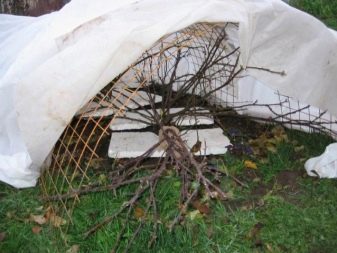
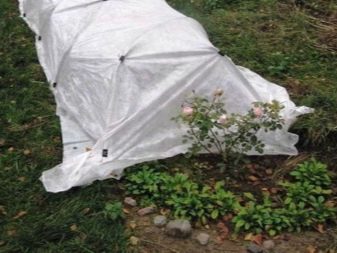
Use in landscape design
Shrub roses look very harmonious in the landscape of garden and park areas and are highly valued by designers.Plants are often used to create living flowering hedges, planting them along the perimeter of the site or on one of its sides. When planting tall varieties, you need to take care of the supports, which are best hidden behind a low-growing shrub planted along the front line. Such layering looks very impressive, especially with the correct selection of shades.
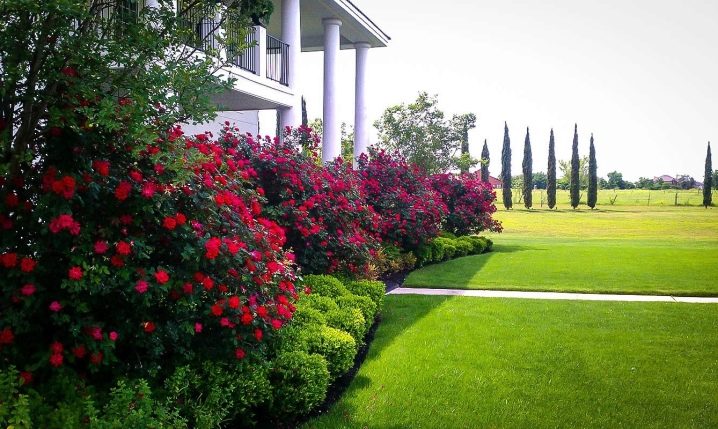
In addition, undersized varieties look great with evergreen trees, emphasizing the harmonious combination of flowers and needles. Ground cover varieties creeping on the ground are used when decorating slopes and curbs, and too long stems are lifted from the ground and fixed on arched structures. Single bushes planted on a lawn or flower bed also look beautiful. With correctly selected neighboring plants, the bush will look like an independent element of landscape design. The main thing in this case is not to overload the flower bed with bright and large flowers, otherwise the rose may get lost in their background.
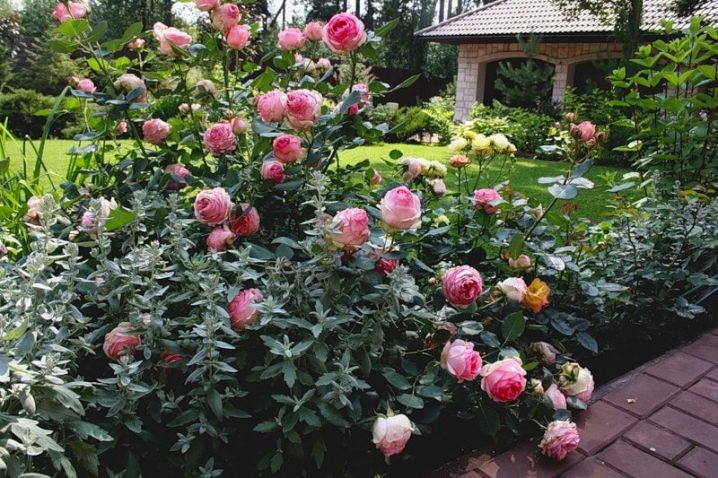
It would be appropriate to plant green non-flowering plants with large leaves, lawn grass and decorate the flower bed with an installation made of natural stone. In this case, the bright flowers of the shtrab will perfectly emphasize the juicy greenery of the flower bed and the elegance of the stone ensemble. Also, shrub roses go well with plants such as thuja, juniper, spruce and fieldfare. Here are some beautiful examples of how to decorate the territory with these colors.
- Groundcover shrub roses in single plantings look very harmonious.
- Shrub roses are successfully combined with large leaves of non-flowering plants.
- A single tall bush on the bank of a man-made pond looks very elegant.
- A hedge of rose scrubs can liven up the site and skillfully disguise the fence.
- A garden arch decorated with creeping scrubs is a prime example of vertical landscaping.
- Delicate roses and cold stone are the harmony of nature.
- Planting in groups of 3-5 and the correct formation of crowns will help achieve the effect of a blooming ball.
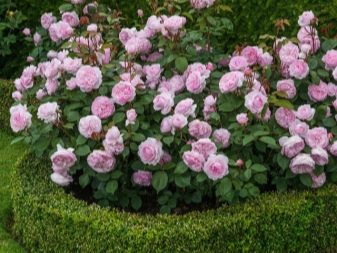

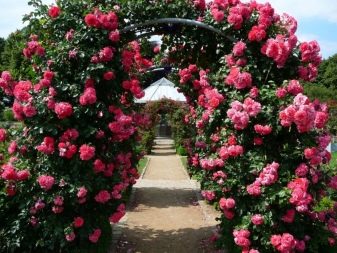
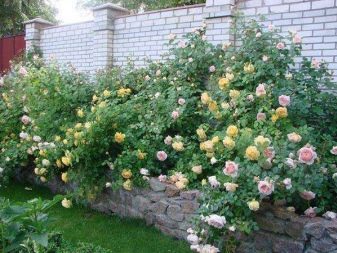
For information on how to grow shrub roses, see the next video.

































































































The comment was sent successfully.